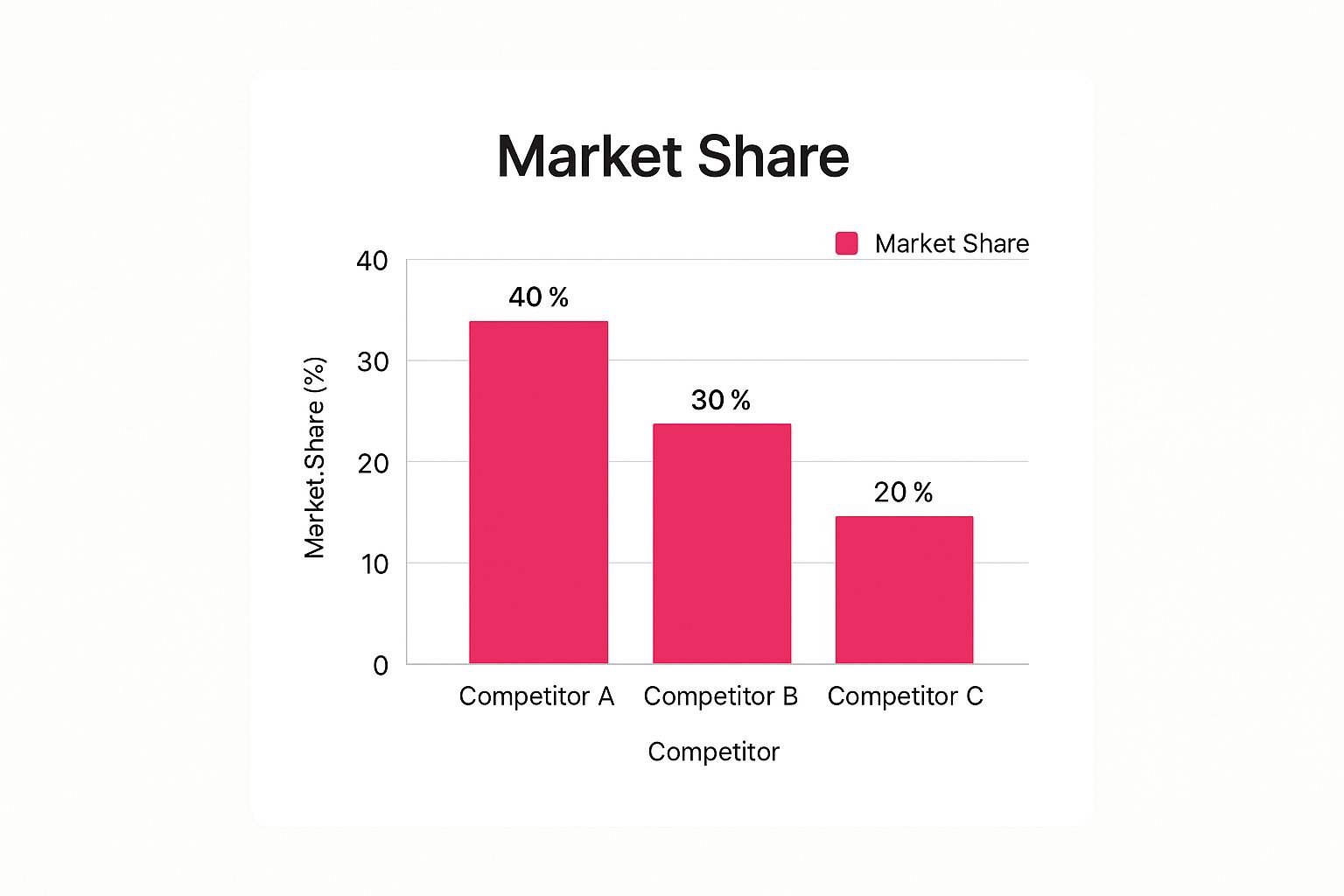Understanding The Digital Revolution In MENA Markets
The Middle East and North Africa (MENA) region is undergoing a significant digital transformation. This shift requires businesses to move away from traditional marketing and embrace digital strategies. Consumer behavior has changed drastically, with digital platforms now integral to daily life. For businesses in MENA, understanding digital marketing isn't just an advantage—it's crucial for survival and growth. Successful brands are already adapting, prioritizing digital channels and tailoring their messages to the region’s cultural nuances.
Mobile-First Is Not A Trend, It’s A Reality
The term "mobile-first" is more than just industry jargon in MENA—it’s a fundamental reality. With a substantial portion of the population accessing the internet primarily through smartphones, businesses must adopt a mobile-centric approach. This involves ensuring websites are responsive and content is easily viewed on smaller screens. Practical steps include prioritizing user experience on mobile when designing landing pages and optimizing videos for mobile viewing. This mobile-first mindset is key for effectively reaching and engaging the target audience.
Cultural Nuances Matter
MENA is a diverse region with distinct cultural sensitivities and linguistic preferences. Effective digital marketing strategies must account for these nuances. This includes recognizing the importance of Arabic content alongside English, customizing campaigns for specific holidays and events, and respecting cultural norms and values. Understanding platform preferences is also critical, as social media and other digital platform usage can vary significantly across MENA countries.
The Rise of Digital Advertising Spend
The move towards digital is apparent in advertising spending trends. The MENA region has seen a considerable increase in digital advertising expenditure. By 2024, internet ad expenditure was projected to grow by approximately 20%. This growth is largely fueled by the increasing use of smartphones and digital platforms. Specifically, the smartphone segment contributed 55.36% of the digital advertising revenue in MENA in 2024. This trend signifies a shift away from traditional advertising methods, with newspaper ad spending predicted to decrease by around 13% by 2024. More detailed statistics can be found here: Digital Advertising in the Middle East and North Africa.
Building A Future-Proof Strategy
A successful digital marketing strategy in MENA requires a deep understanding of the region’s unique digital landscape. By prioritizing mobile, respecting cultural nuances, and acknowledging the shift towards digital spending, businesses can position themselves for success. This foundational knowledge is vital for creating campaigns that resonate with MENA audiences and deliver tangible results in this dynamic market.
Setting Goals That Actually Drive Business Growth
Forget generic objectives. This section focuses on setting digital marketing goals that genuinely transform your business. We'll explore how thriving MENA brands structure their objectives to align with regional realities and cultural expectations. Through real-world examples, you’ll learn to pinpoint the metrics that truly matter for your industry and how to balance ambitious growth with achievable timelines.
Defining SMART Goals for the MENA Market
While the concept of SMART goals (Specific, Measurable, Achievable, Relevant, Time-bound) is universal, its application in the MENA region requires a nuanced approach. For example, a “relevant” goal in the UAE might involve increasing engagement during Ramadan, leveraging culturally significant moments to connect with your audience. You might be interested in: How to master lead generation in Dubai.
- Specific: Instead of “increase brand awareness,” aim for “increase Instagram followers by 20% in Q2.”
- Measurable: Track website traffic, conversion rates, and social media engagement using Google Analytics.
- Achievable: Consider market saturation and competition when setting realistic targets.
- Relevant: Ensure your goals align with your overall business objectives and resonate with the MENA market.
- Time-bound: Set deadlines for achieving each goal to maintain momentum and accountability.

KPIs That Resonate in MENA
Certain Key Performance Indicators (KPIs) work particularly well in MENA markets. For instance, customer lifetime value (CLTV) is crucial, reflecting the importance of building long-term relationships in a culture that values loyalty. Additionally, engagement metrics on platforms like Instagram and WhatsApp—heavily used in the region—offer valuable insights into campaign effectiveness.
Balancing Short-Term Wins and Long-Term Brand Building
A successful digital marketing strategy considers both immediate gains and sustainable growth. This means focusing on KPIs that contribute to short-term wins, like lead generation, while simultaneously investing in brand-building activities. For instance, building an engaged community on social media might not translate into immediate sales, but it fosters brand loyalty that drives long-term growth. This balanced approach is vital for achieving lasting success in the competitive MENA digital market. Focusing on measurable objectives ensures each campaign contributes to overall business growth.
Decoding Your MENA Audience Like A Pro
Understanding your MENA (Middle East and North Africa) region audience requires more than just basic demographics. It demands cultural intelligence. This means understanding the values, beliefs, and behaviors that influence consumer decisions. This section explores advanced research methods that reveal genuine insights into your target market, forming the foundation of a resonant digital marketing strategy.
Social Listening Across Languages
Effective social listening in the MENA region requires monitoring conversations in both Arabic and English. This bilingual approach provides a more holistic view of consumer sentiment and emerging trends. Tools like Brand24 help track mentions and analyze conversations across social media platforms. Understanding nuances in online discussions about a specific product reveals valuable information about consumer preferences and potential pain points, which is crucial for tailoring messaging and product development.
Psychographic Profiling and Cultural Values
Psychographic profiling delves deeper than demographics, exploring the values, lifestyles, and interests of your audience. Understanding cultural nuances in the MENA region is paramount. Respecting religious practices, considering family dynamics, and acknowledging regional differences in consumer behavior are key, as these factors significantly influence purchasing decisions and brand preferences. This deeper understanding allows for the creation of more targeted and effective campaigns.

Building Representative Buyer Personas
Creating accurate buyer personas is essential for any successful digital marketing strategy. In the MENA region, this means developing personas that reflect the region's multicultural complexity. For example, one persona might represent a young, tech-savvy professional in Dubai, while another represents a mother of three in Riyadh. Each persona should have distinct characteristics, needs, and online behaviors, allowing you to visualize your ideal customer and personalize your marketing efforts.
- Demographics: Age, location, gender, income, education
- Psychographics: Values, interests, lifestyle, personality
- Online Behavior: Preferred platforms, content consumption habits, purchasing behavior
Validating Your Assumptions Through Data Collection
While building personas is crucial, validating those assumptions with data is equally important. This involves gathering data through surveys, focus groups, and website analytics. Analyzing website traffic, for instance, reveals insights into user behavior and preferences. Running targeted surveys helps understand specific customer needs and pain points. This continuous feedback loop refines your buyer personas, ensuring they accurately reflect your target audience. This constant refinement ensures your digital marketing strategy stays relevant and effective within the MENA market. Investing in audience research is fundamental to successful digital marketing campaigns in the region.
Choosing Channels That Actually Deliver Results
With a multitude of digital channels competing for marketing funds, strategic channel selection is essential. This section explores which platforms deliver substantial ROI for businesses in the Arab Emirates and the wider MENA region, outlining how to build a channel mix that maximizes reach without overspending. We'll delve into unique digital behaviors across diverse MENA markets, from bilingual search patterns to social media nuances by country. This knowledge is fundamental for crafting a resonant digital marketing strategy.
Navigating the MENA Digital Landscape
The MENA region presents a vibrant and diverse digital landscape. Understanding platform preferences is vital, as social media and other digital channel usage differs significantly across countries. For example, while Instagram might be highly effective in the UAE, other platforms may be more prominent in Saudi Arabia or Egypt. This underscores the importance of tailoring your channel strategy to each specific market. You might be interested in: Learn more in our article about social media management in Dubai. Additionally, bilingual search patterns, where users frequently switch between Arabic and English, necessitate SEO strategies that accommodate both languages. This ensures maximum visibility and reach within your desired audience.
Matching Channels to Your Audience
Selecting the right channels depends on understanding your target audience’s preferences and online behavior. This involves in-depth audience research, crafting detailed buyer personas, and analyzing existing platform usage data. For instance, if your target market primarily uses Snapchat, a large investment in LinkedIn marketing may not be the most effective approach. Similarly, understanding preferred content formats, whether video, text, or interactive content, will inform channel choices. This targeted approach ensures your message connects with the right people on their preferred platforms.

This infographic illustrates the market share of three main competitors. Competitor A dominates with 40%, followed by Competitor B at 30%, and Competitor C at 20%. This data highlights the importance of competitive analysis when selecting digital marketing channels and allocating budget strategically. Understanding the competitive landscape helps identify opportunities to differentiate your brand and maximize impact.
To further illustrate effective channel selection in the MENA region, let's examine a comparison of various digital marketing avenues. The following table provides a comparative analysis of major digital marketing channels, highlighting their effectiveness, cost, and reach for MENA markets.
Digital Marketing Channels Comparison for MENA Region
Comparative analysis of major digital marketing channels showing effectiveness, cost, and reach for MENA markets
| Channel | Effectiveness Rating | Average Cost | Primary Audience | Best Use Cases |
|---|---|---|---|---|
| Search Engine Optimization (SEO) | High | Variable (Dependent on strategy) | Wide Reach | Brand building, driving organic traffic |
| Social Media Marketing | Medium-High | Variable (Organic vs. Paid) | Targeted demographics | Brand awareness, community building, lead generation |
| Paid Advertising (PPC) | High | Variable (CPC, CPM) | Specific target audiences | Driving immediate traffic and conversions |
| Email Marketing | Medium | Low | Existing customers and leads | Nurturing leads, promoting offers, building customer loyalty |
| Influencer Marketing | Medium-High | Variable (Influencer fees) | Niche audiences | Reaching specific demographics and building trust |
This table demonstrates the diverse strengths of each channel. While SEO offers wide reach and long-term brand building, paid advertising provides immediate results. Social media marketing effectively targets specific demographics and email marketing strengthens relationships with existing customers. Influencer marketing offers unique opportunities to reach niche audiences and build trust.
Optimizing Your Channel Mix and Budget
Developing a powerful channel mix involves more than simply choosing the right platforms. It requires careful budget allocation to ensure optimal ROI. This includes analyzing the cost-effectiveness of each channel and prioritizing those aligned with your business goals. While paid advertising can deliver immediate results, organic social media strategies cultivate long-term brand equity. A balanced approach maximizes reach and impact without excessive spending. Continuous monitoring and performance analysis allow for data-driven adjustments and optimization, ensuring your digital marketing strategy remains agile and effective in the dynamic MENA digital landscape.
Creating Content That Connects And Converts
Content marketing in the MENA region requires a deep understanding of the local audience. It's more than just translation; it demands cultural fluency and creating content that genuinely resonates within the diverse cultural contexts of the region. Maintaining brand consistency is also vital for building trust. This section explores strategies for creating engaging content, focusing on the growing power of video and multilingual approaches. Check out our guide on content creation.
Leveraging the Power of Video
Video content is booming in the MENA region, making it a crucial part of any successful digital marketing strategy. Creating high-quality video content doesn't have to be expensive. Cost-effective strategies like user-generated content, behind-the-scenes glimpses of your business, and short, impactful mobile-optimized clips can be highly engaging without requiring extensive production resources. These approaches allow you to connect with your audience authentically and economically. Furthermore, incorporating video caters to the growing preference for visual content consumption across the region.
For example, creating short, informative videos in Arabic about your products or services addresses local language preferences and delivers valuable information in an easily digestible format. This targeted approach can significantly boost engagement and brand awareness.
Multilingual Content That Maintains Authenticity
Reaching a wider audience in the MENA region requires content in multiple languages, particularly Arabic and English. However, simple translation isn't enough. Maintaining authenticity and cultural relevance in each language is key. Partnering with local copywriters ensures your message resonates with the specific nuances of each target market. Tailoring the tone and style of your Arabic content to reflect local dialects and cultural sensitivities strengthens your connection with the audience, building trust and enhancing your brand’s image.
This attention to detail demonstrates a genuine commitment to understanding and engaging with the local culture, essential for building strong customer relationships.
Planning and Testing Creative Strategies
Effective content requires a structured approach. Start by developing a clear content calendar that outlines topics, formats, and publishing schedules. This organized approach ensures consistent output and aligns your content with broader marketing goals. Testing different creative strategies is also crucial. A/B testing various headlines, visuals, and call-to-actions helps optimize your content for maximum impact. Continuously analyzing performance metrics and using data-driven insights allows you to refine your approach and improve results over time.
The growing importance of digital marketing in the MENA region is reflected in the growth of video advertising. Video ad spend in MENA is expected to reach $2.8 billion by 2025, a substantial increase from $1.1 billion in 2020. This represents a remarkable 20.6% compound annual growth rate (CAGR). Find more detailed statistics here. Growth is particularly significant in Saudi Arabia, where video ad spending is projected to reach $1.2 billion by 2025, growing at a CAGR of 22% between 2020 and 2025. This further underscores the importance of incorporating video content into your digital marketing strategy.
Balancing Global Standards With Local Relevance
Many businesses in the MENA region need to balance global brand standards with local market nuances. This involves adapting your content strategy to resonate with local culture while maintaining a cohesive brand identity across all markets. Collaborating with regional experts who understand both your brand and the local culture is essential. Their insights ensure your messaging remains consistent with your global brand identity while respecting cultural sensitivities and preferences within the MENA region. Successfully navigating this balance is key to building a strong brand presence across international markets.

Mastering Analytics For Continuous Optimization
Data without action offers little value. This section explores how using analytics can provide actionable insights to enhance your digital marketing strategy in the MENA region, all while adhering to data privacy regulations. We'll delve into the key metrics for success, from acquisition costs to lifetime value calculations, and demonstrate how to establish effective tracking systems. Our goal is to empower you to make intelligent, data-driven decisions in this dynamic market.
Setting Up Your Analytics System
Selecting the right analytics tools is the first crucial step. Google Analytics remains a robust and free option, offering extensive data on website traffic and user behavior. For social media, platform-specific analytics dashboards provide critical insights into engagement and reach.
Integrating these platforms with Customer Relationship Management (CRM) systems offers a complete view of the customer journey. This integration enables you to track interactions across multiple channels, from initial contact to final conversion. It creates a central hub for all your marketing data, simplifying the process of identifying trends and optimizing campaigns.
Key Metrics for MENA Digital Marketing Success
Monitoring the right metrics is paramount for understanding campaign performance and making informed decisions. Website traffic, bounce rate, and conversion rate, for instance, reveal how effectively your website attracts and converts visitors.
This data helps pinpoint areas for improvement, such as optimizing landing pages or streamlining the checkout process. For paid campaigns, metrics like cost-per-click (CPC) and return on ad spend (ROAS) are vital for assessing ROI and ensuring efficient budget allocation. Understanding these metrics allows you to refine your targeting and bidding strategies.
Measuring What Matters: Acquisition Costs and Lifetime Value
Understanding acquisition costs is fundamental, particularly within the unique dynamics of the MENA market. Analyze how much it costs to acquire a new customer through various channels. Higher customer acquisition costs might necessitate strategic adjustments in your marketing mix or pricing strategies.
Lifetime value (LTV) calculations should consider cultural loyalty patterns in the MENA region, providing valuable insights into long-term customer profitability. This long-term perspective emphasizes the importance of building strong relationships and fostering customer loyalty.
The MENA digital marketing analytics market is experiencing significant growth. Reaching a value of USD 90.36 million by 2024, this underscores the increasing importance of data-driven decision-making in the region. Learn more about these market trends: Middle East and Africa Digital Marketing Analytics Market Report.
From Data to Action: Optimizing Your Strategy
Analyzing data is only meaningful when it informs action. Regularly review your key metrics and identify trends to shape your strategy. A high bounce rate on a particular landing page, for example, suggests a need for improved design or content. A/B testing can help determine the most effective approach.
Tracking conversion rates across different channels helps identify which platforms deliver the best ROI. This data enables you to adjust budget allocation and optimize campaigns for maximum impact. This iterative process of analysis and optimization is key to continuous improvement.
To illustrate key metrics for success in the MENA region, the following table provides a helpful overview:
Essential Digital Marketing KPIs for MENA Businesses
Key performance indicators and benchmarks for measuring digital marketing success in MENA markets
| KPI Category | Primary Metrics | MENA Benchmark | Measurement Frequency | Tools Required |
|---|---|---|---|---|
| Website Traffic | Unique visitors, page views, bounce rate | Industry specific | Weekly/Monthly | Google Analytics |
| Social Media Engagement | Likes, shares, comments, reach | Platform specific | Daily/Weekly | Platform analytics dashboards |
| Lead Generation | Conversion rate, cost per lead | Varies by campaign | Weekly/Monthly | CRM, marketing automation tools |
| Sales | Revenue, conversion rate, average order value | Business objectives | Daily/Weekly/Monthly | E-commerce platforms, analytics dashboards |
| Customer Satisfaction | Customer reviews, Net Promoter Score (NPS) | Industry specific | Quarterly/Annually | Survey tools, CRM |
This table highlights the essential KPIs to track, their benchmarks, and the tools required for accurate measurement. By regularly monitoring these KPIs, businesses can gain valuable insights into their performance and make data-driven decisions to optimize their strategies.
Key Takeaways And Your Implementation Roadmap
Creating a robust digital marketing strategy for the MENA region requires a deep understanding of this diverse market. This roadmap distills key takeaways into actionable steps you can implement today, prioritizing initiatives based on impact and resources.
Critical Success Factors in the MENA Region
Several key factors differentiate successful MENA-focused digital marketing strategies. Localization is paramount, going beyond translation to encompass cultural nuances. Mobile optimization is crucial due to high mobile penetration rates. Understanding platform preferences is also key, as social media usage varies across MENA countries. Building relationships and trust, aligning with cultural values, is also vital. These factors guide a high-impact strategy.
Building Your Implementation Roadmap
Developing a digital marketing strategy can seem daunting, but breaking it down simplifies implementation. Start by defining SMART goals (Specific, Measurable, Achievable, Relevant, Time-bound) aligned with business objectives. Conduct thorough audience research, creating buyer personas reflecting your target market's demographics and cultural nuances.
Choose effective digital channels resonating with your audience, optimizing your channel mix based on MENA platform preferences. Create high-quality, localized content speaking directly to your target market. Finally, establish robust analytics tracking to monitor metrics and optimize your strategy using data-driven insights.
-
Phase 1: Foundation (1-3 Months): Focus on market research, goal setting, and audience profiling. Establish your online presence and select key digital channels.
-
Phase 2: Content and Engagement (3-6 Months): Develop localized content connecting with your audience. Implement your social media strategy and build an engaged online community.
-
Phase 3: Optimization and Growth (6-12 Months): Monitor key metrics, analyze data, and optimize campaigns. Refine your targeting and explore new channels for growth. Continuously adapt to the changing digital landscape.
Avoiding Common Pitfalls
Be mindful of potential challenges. Neglecting cultural nuances is a common mistake. Content should resonate with the local culture. Underestimating the importance of mobile is another pitfall. Ensure your website and content are mobile-optimized. Spreading resources too thin across numerous channels without focus can hinder success. Concentrate on relevant platforms. Finally, failing to track and analyze data prevents identifying improvements and maximizing ROI.
Measuring Success and Adapting Your Approach
Track relevant Key Performance Indicators (KPIs), such as website traffic, conversion rates, social media engagement, or lead generation. Regularly monitor progress towards your SMART goals.
The dynamic digital marketing landscape requires ongoing adaptation. Regularly analyze data, identify emerging trends, and adjust your strategy. This agile approach ensures your efforts remain effective in the evolving MENA market.
Ready to transform your digital presence in the MENA region? Grassroots Creative Agency, a leading digital marketing firm in Dubai, offers bespoke strategies tailored to your business objectives. We specialize in social media management, branding, website design, content creation, and more. From targeted paid advertising to analytics-driven performance tracking, we guide businesses through every stage of digital growth. Visit Grassroots Creative Agency today to learn how we can help you achieve measurable results in the dynamic MENA market.








